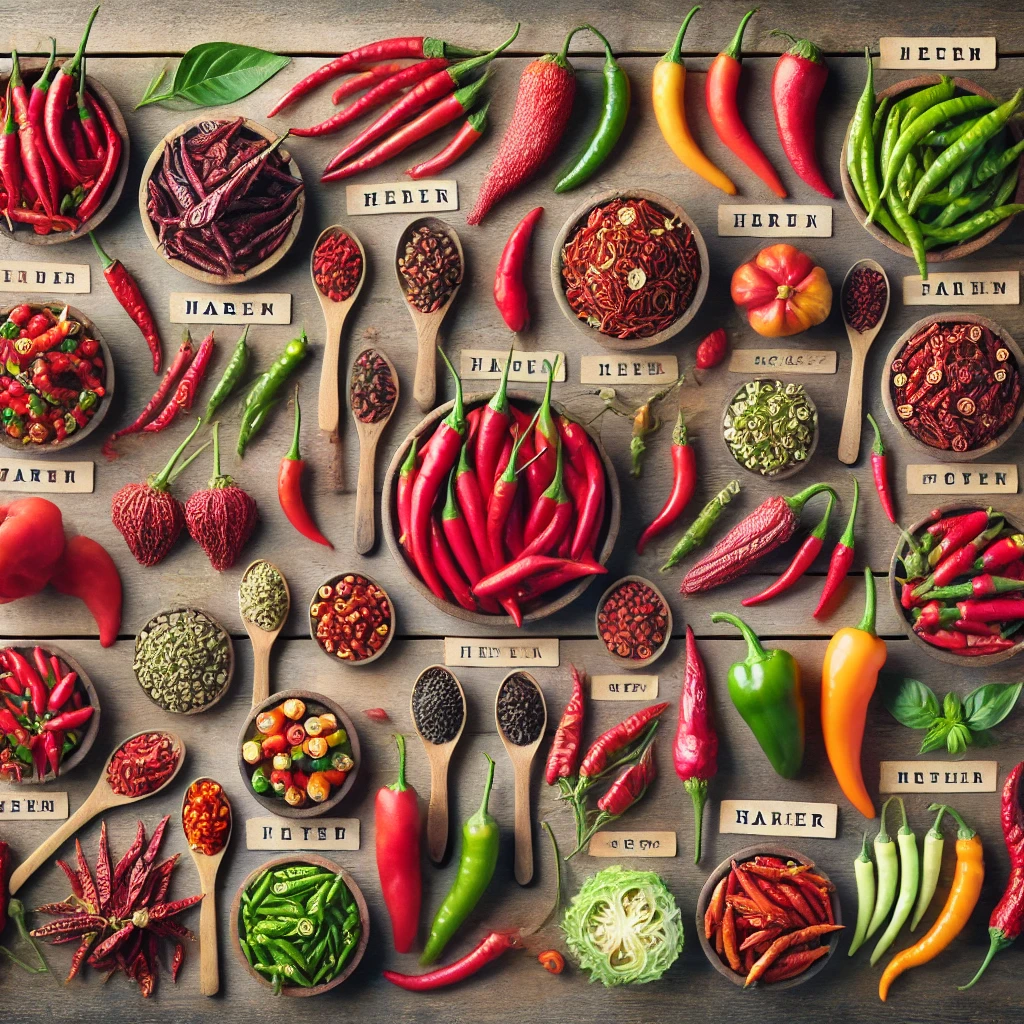For as long as food has existed, the question of how much heat in food is appropriate has been a subject of debate. Some chefs and culinary purists argue that certain dishes make no sense with (or without) heat, while food lovers complain about dishes being too spicy—or too mild. This discussion often sparks cultural debates, with heat levels sometimes becoming a defining characteristic of entire cuisines.
Heat in food is sometimes confused with spices and herbs, which distracts from the essential question—how do I adjust the heat to my preference while preserving the dish’s intended taste? Does adding extra chilli flakes to your beautiful Roman pizza ruin the Italian experience? Is a mild chilli con carne or tawa masala an inauthentic representation of what Mexican or Indian food tastes like?
Many home cooks are hesitant to adjust heat levels in a recipe out of the fear of ruining the dish. Some others assume that all chillies are interchangeable. Neither of these extreme stances are actually ideal.
Choosing the right chilli is more than just picking one with the ‘right’ amount of heat. Understanding how different chillies contribute to flavour can help us make better substitutions without losing the essence of a dish.

Heat vs. Taste: The Science of Spice
Heat is not a taste. Years of research show that the heat we perceive in food is actually a pain response triggered by capsaicin, the active compound in chilli peppers. This sensation is processed by nerves, not taste buds. Just as individuals have varying pain tolerances, we all have different spice thresholds. This is why a dish that’s pleasantly warm for one person might be overwhelmingly hot for another.
Chillies add more than just heat. While we often associate chillies with spiciness, they also have distinct flavour profiles. Some are fruity and citrusy, while others are earthy, smoky, or floral. These characteristics can dramatically affect the final taste of a dish, making it essential to choose the right chilli beyond just its spice level.
A Better Way to Classify Chillies
Most guides focus only on heat levels, using the Scoville scale to rank chillies by their spiciness. While this is helpful in gauging tolerance, it doesn’t help us understand which chillies can be substituted for one another. The real question is: how can we control heat levels in a dish while staying true to its intended taste?
Therefore, let’s categorize chillies based on both heat and flavour profile:
| Main taste note / Scoville Units | 0 to 2,500 (mild) | 2,500 to 10,000 (mild hot) | 10,000 to 30,000 (medium) | 30,000 to 100,000 (hot) | 100,000 to 350,000 (spicy hot) | 350,000+ (extremely hot) |
|---|---|---|---|---|---|---|
| Neutral (Peppery) | Japones Royal Black | Black Cuban | ||||
| Clean & Peppery | Thai Birdseye | |||||
| Sweet | Pimento Kashmiri | Cajun Belle Hot Paprika Fire & Ice | Byadgi | |||
| Fruity | Dundicut | Ripe Habanero | ||||
| Sweet & Floral | Chilaca | |||||
| Fruity & Tangy | Green Habanero Wiri Wiri | |||||
| Sweet & Fruity | Ancho | Sandia Puya | Jwala Bulgarian Carrot | Rocoto Chilli Thai Dragon | Scotch Bonnet White Habanero | Carolina Reaper |
| Sweet & Spicy | Purple Jalapeno | Reshampatti | ||||
| Sweet & Citrusy | Shishito | Guajillo | Lemon Drop Manzano | |||
| Sweet & Tangy | Hungarian Wax Pepper | Malagueta | ||||
| Earthy | Poblano | |||||
| Earthy & Pungent | Sannam Cayenne | Kanthari | ||||
| Earthy & Sweet | Padron | Thai | ||||
| Earthy & Fruity | Pasilla | Ghost Pepper (Bhut Jholokia) | ||||
| Grassy | Arbol | Serrano | ||||
| Citrusy | Jalapeno | |||||
| Pungent | Baklouti | |||||
| Smoky & Sweet | Anaheim | Fresno Aleppo | Chipotle | Calabrian Piri Piri | Red Habanero Naga Morich | |
| Smoky & Fruity | Tabasco Pequin | Chocolate Habanero Bhut Jholokia Chocolate | ||||
| Smoky & Earthy | Hatch | Arbol | Chiltepin |
Now that we have this table, it is quite easy to substitute chillies for one another while maintaining an authentic taste. Just choose a milder or hotter chilli along the rows and you should have a roughly similar taste in your dish.
Heat in food: Does Adjusting Spice Levels Alter a Dish’s Authenticity?
Some culinary purists argue that adding or reducing heat changes the authenticity of a dish. In reality, heat levels should be adjusted based on personal preference while maintaining the intended flavour balance.
Each person has a different spice threshold. If a dish is too spicy, the pain response can overshadow other flavours. If it’s too mild, it may not stimulate the taste buds enough to be enjoyable. This explains why a European chef might claim that adding chillies masks delicate herbs, while someone accustomed to higher spice levels may find a dish bland without heat.
The key takeaway? The ‘right’ amount of spice is personal and cultural. However, by choosing chillies that align with a dish’s original flavour profile, we can make heat adjustments without compromising authenticity.
What chillies do I use?
I thought it would be useful to add links to some of my favourite chillies. Now, I love a kick in my food and a lot of chillies I use are really hot. The best part is that you can substitute these chillies for their milder counterparts using the table above!
- For most Indian curries: I love using the Reshampatti chili powder. While it packs a powerful spice, I love the peppery sweetness that perfectly complements the spicy masalas, sourness and sweetness in Indian dishes.
- For curries and herby dishes with a green base (eg. Thai green curry, a pesto pasta or this Undhiyu): I love using Green Habanero. My absolute favourite is the El Yucateco Salsa Picante as fresh Habanero is not readily avaialbe in the UK.
- For pastas: For pastas with a tomato base, I love using Red Habanero. It packs a higher heat but has the same flavour profile that the traditional Italian Calabrian chillies are known for. In creamy pasta dishes like this Aglio e Olio or the Cavolo Nero Walnut pesto pasta or this Lemon Ricotta pasta, I love using red Scotch Bonnet Peppers. I buy fresh Scotch Bonnet chillies from Waitrose & Partners.
- For soups and stews: For bean soups, I love using Scotch Bonnet peppers (Scotch Bonnet chillies). However, for green soups, I love using the Green Habanero (El Yucateco Salsa Picante). However, for soups that are sweeter, like tomato and butternut squash soups, I love using Reshampatti chili powder.
While this is a broad guide, I also love using regional spices for several dishes. For example, in Chinese hot pots and noodles, my favourite is Sichuan Peppercorns. I buy the East Asia Dried Sichuan pepper. Similarly, in Middle Eastern fare, I love using sumac. Since I don’t use this in large quantities, I just get my Sumac from Waitrose & Partners.
Needless to say, I rely on the El Yucateco range and Cholula Original Hot Sauce for all the heat in my Mexican dishes. In fact, I love using Cholula in all the dishes that can use a tangy and sweet heat. It goes extremely well as a hot sauce on a tomato-based Neapolitan pizza.
Final Thoughts on Heat in food
Understanding chillies beyond just their heat level allows us to control spice while staying true to a dish’s flavour. By using the table above, you can substitute chillies based on both heat and taste, ensuring your dishes remain balanced and delicious.
I hope this guide helps you experiment with spice in a way that enhances your cooking! Let me know your thoughts in the comments. What’s your favourite chilli, and how do you use it?
